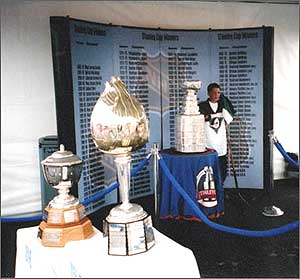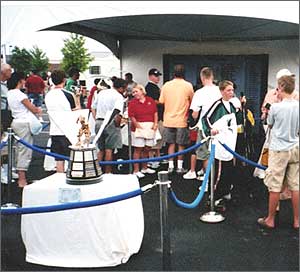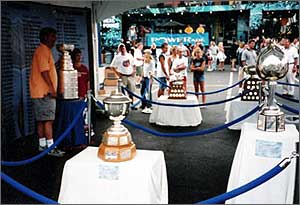(August 18, 2003) — On Thursday morning, August 7, the Stanley Cup left Sweden for a flight back to North America. Its destination the next day would be Columbus, Ohio - part of NHL Breakout.
 |
| A young Anaheim Mighty Duck fan gets his picture taken with the Stanley Cup at NHL Breakout in Columbus, OH with the James Norris and Hart Memorial trophies also on display throughout the weekend. |
Columbus began its NHL odyssey with the drop of the first puck October 7, 2000 in an opening night game versus the Chicago Black Hawks. Although they would end up on the losing side of a 5-3 decision, the sellout crowd of 18,136 roared its approval for the Blue Jackets. Bruce Gardiner scored the inaugural goal for Columbus. From that moment onward, Columbus was a big league franchise. And they continue to prove it day by day. The Stanley Cup drew massive lineups in Columbus. Fans lined up for 30 to 45 minutes to see, touch and read the Stanley Cup. "To see this kind of support for a hockey event in early-August is unprecedented," mentioned Phil Pritchard, the Hockey Hall of Fame's VP of Operations and a guy who has seen more than his share of similar events.
Columbus may be new to the NHL, but they aren't new to hockey and they certainly aren't new to sports. The Columbus Crew are a Major League Soccer franchise. The Columbus Clippers play International League baseball. There are the neighbouring Cleveland Indians and Cincinnati Reds playing major league baseball, while the Cleveland Browns and Cincinnati Bengals play NFL football. The Columbus Blue Jackets, of course, are an exciting NHL franchise, and the Columbus Stars will begin play in the United Hockey League this fall. Then…there are the Buckeyes. The national champion Ohio State Buckeyes!
 |
Many hockey fans came out to NHL Breakout in Columbus, OH to see many of the NHL trophies including the Maurice Richard Trophy awarded to the NHL's
leading goal scorer. |
The Stanley Cup was on exhibit Friday, Saturday and Sunday, August 8, 9 and 10 as part of NHL Breakout. The Hockey Hall of Fame was on hand, not only with the Stanley Cup, but with the Calder Trophy (rookie of the year), Hart Trophy (most valuable player), Norris Trophy (best defenseman) and the Vezina Trophy (best goaltender). One onlooker remarked, "Oh my God, what a great display of silverware!" There were also street hockey games, roller hockey tournaments, interactive games, beer tents and bands. ESPN was on site as was PowerAde, while the Columbus Blue Jackets reached out into the community with several of their players signing autographs. Popular Jean-Luc Grand-Pierre drew a great deal of attention, as did new acquisition Darryl Sydor making his first appearance as a Blue Jacket.
NHL Breakout drew hockey fans from throughout the geographic area. Although license plates illustrated the point with a mix of Ohio, Michigan, Indiana, Kentucky, Missouri and Ontario vehicles, it was the variety of hockey sweaters that drove home the point. Red Wings, of course, were evident due not only to Detroit's proximity to Columbus but attesting to the team's immense popularity, but there were plenty of sweaters from the Blues, Black Hawks, Maple Leafs and sundry others. But encouraging for hockey was the absolute domination of Blue Jackets' sweaters. Columbus hasn't come so far since the Nina, Pinta and Santa Maria!
 |
For three day's hockey fans came to get their picture taken with the Stanley Cup and see some
of the NHL's individual trophies. |
For three days, fans lined up to get their picture taken with the Stanley Cup, to trace the legendary names etched into the Cup's patina, to wrap their arms around the silverware like so many of their hockey heroes had done before. At any given time through the weekend, there were 300 to 450 people waiting their turn in line, resulting in waits of up to two hours to see the Stanley Cup.
Hockey is very much alive and doing very well in Columbus, Ohio!
Following the sojourn to Columbus, the Stanley Cup visited rookie hero Michael Rupp in Cleveland, and you'll read about that trip in Wednesday's Stanley Cup Journal.
Kevin Shea chronicles hockey history from his home in Toronto.
|